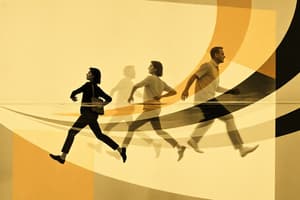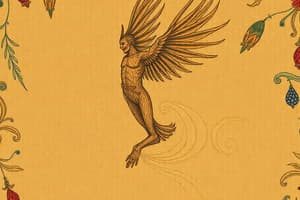Podcast
Questions and Answers
Match the following movement with its definition:
Match the following movement with its definition:
Flexion = Decreasing the angle between two bones. Extension = Increasing the angle between two bones. Hyperextension = Extension beyond the normal range. Abduction = Moving a limb away from the midline of the body. Adduction = Moving a limb toward the midline of the body. Dorsiflexion = Flexing the foot upward. Plantar Flexion = Flexing the foot downward.
Match the following muscle structure with its description:
Match the following muscle structure with its description:
Muscle Fiber = A skeletal muscle cell. Endomysium = Connective tissue covering each muscle fiber. Fascicles = A bundle of muscle fibers. Perimysium = Connective tissue encasing fascicles. Epimysium = A connective tissue layer that surrounds a muscle as a whole. Fascia = A layer of connective tissue outside the epimysium.
Match the following muscle fiber organelle with its function:
Match the following muscle fiber organelle with its function:
Sarcolemma = The plasma membrane of a muscle fiber. Sarcoplasm = The cytoplasm of a muscle cell. Myofibrils = Bundles of proteins that fill the muscle fiber and allow contraction. Sarcoplasmic Reticulum = A smooth endoplasmic reticulum that stores calcium ions. Transverse (T) Tubules = Tubules that allow electrical impulses to travel deep into the cell.
Which muscle type is found only in the heart?
Which muscle type is found only in the heart?
Which muscle type is nonstriated and involuntary?
Which muscle type is nonstriated and involuntary?
Which muscle type is responsible for voluntary movement?
Which muscle type is responsible for voluntary movement?
What are intercalated disks associated with?
What are intercalated disks associated with?
Where is smooth muscle commonly found?
Where is smooth muscle commonly found?
What connects actin filaments during muscle contraction?
What connects actin filaments during muscle contraction?
What is formed when myosin heads latch onto actin filaments?
What is formed when myosin heads latch onto actin filaments?
What are the 'power strokes' during muscle contraction?
What are the 'power strokes' during muscle contraction?
What structure is pulled closer together during muscle contraction?
What structure is pulled closer together during muscle contraction?
What shortens during a muscle contraction?
What shortens during a muscle contraction?
What is the smallest contractile unit of a muscle fiber?
What is the smallest contractile unit of a muscle fiber?
What protein forms the thin filaments in a sarcomere?
What protein forms the thin filaments in a sarcomere?
What attaches actin to the Z-discs?
What attaches actin to the Z-discs?
What propels the myofilaments toward the sarcomere's center?
What propels the myofilaments toward the sarcomere's center?
What is the largest and most complex joint in the body?
What is the largest and most complex joint in the body?
Which joint is most likely to dislocate?
Which joint is most likely to dislocate?
What is the function of ligaments in synovial joints?
What is the function of ligaments in synovial joints?
Which joint allows movement in one plane, like flexion and extension?
Which joint allows movement in one plane, like flexion and extension?
Which joint type provides the widest range of motion?
Which joint type provides the widest range of motion?
Which joint type permits flat bones to slide over each other?
Which joint type permits flat bones to slide over each other?
Which joint type allows movement back and forth and side-to-side?
Which joint type allows movement back and forth and side-to-side?
Which joint type permits flexion, extension, and side-to-side movement?
Which joint type permits flexion, extension, and side-to-side movement?
What is the purpose of bursae in synovial joints?
What is the purpose of bursae in synovial joints?
Which part of a synovial joint reduces friction between bones?
Which part of a synovial joint reduces friction between bones?
What is the space between bones in synovial joints called?
What is the space between bones in synovial joints called?
What type of connective tissue forms the joint capsule in synovial joints?
What type of connective tissue forms the joint capsule in synovial joints?
Which joint type includes the humeroulnar and humeroradial joints?
Which joint type includes the humeroulnar and humeroradial joints?
Which joint is an example of a ball-and-socket joint?
Which joint is an example of a ball-and-socket joint?
Which joint type is involved in the movement of the wrist?
Which joint type is involved in the movement of the wrist?
What structure connects bones and stabilizes synovial joints?
What structure connects bones and stabilizes synovial joints?
Which joint type allows the head of one bone rotate within a socket?
Which joint type allows the head of one bone rotate within a socket?
Match the following muscle structure with its correct description:
Match the following muscle structure with its correct description:
What neurotransmitter is secreted to initiate muscle contraction?
What neurotransmitter is secreted to initiate muscle contraction?
Where does acetylcholine diffuse during muscle contraction?
Where does acetylcholine diffuse during muscle contraction?
What happens when calcium binds to troponin during muscle contraction?
What happens when calcium binds to troponin during muscle contraction?
Which structure releases calcium to enable muscle contraction?
Which structure releases calcium to enable muscle contraction?
What happens to the Z-disks during an overly contracted muscle fiber?
What happens to the Z-disks during an overly contracted muscle fiber?
In an overly stretched muscle fiber, contraction is weak because:
In an overly stretched muscle fiber, contraction is weak because:
What condition allows for the strongest muscle contraction?
What condition allows for the strongest muscle contraction?
What is the phenomenon called when a muscle contracts stronger with each consecutive stimulus?
What is the phenomenon called when a muscle contracts stronger with each consecutive stimulus?
When muscle contractions build on previous ones without full relaxation, it is called:
When muscle contractions build on previous ones without full relaxation, it is called:
What results when muscle twitches merge into one prolonged contraction?
What results when muscle twitches merge into one prolonged contraction?
What are the basic units of myofibrils called?
What are the basic units of myofibrils called?
Thin filaments are composed of:
Thin filaments are composed of:
Muscle fascicles are made up of:
Muscle fascicles are made up of:
Myofilaments are primarily made of:
Myofilaments are primarily made of:
Which structure allows electrical impulses to travel deep into the muscle fiber?
Which structure allows electrical impulses to travel deep into the muscle fiber?
Flashcards
Flexion
Flexion
Decreasing the angle between two bones.
Extension
Extension
Increasing the angle between two bones.
Hyperextension
Hyperextension
Extension beyond the normal range.
Abduction
Abduction
Signup and view all the flashcards
Adduction
Adduction
Signup and view all the flashcards
Dorsiflexion
Dorsiflexion
Signup and view all the flashcards
Plantar Flexion
Plantar Flexion
Signup and view all the flashcards
Circumduction
Circumduction
Signup and view all the flashcards
Rotation
Rotation
Signup and view all the flashcards
Internal Rotation
Internal Rotation
Signup and view all the flashcards
External Rotation
External Rotation
Signup and view all the flashcards
Supination
Supination
Signup and view all the flashcards
Pronation
Pronation
Signup and view all the flashcards
Inversion
Inversion
Signup and view all the flashcards
Eversion
Eversion
Signup and view all the flashcards
Protraction
Protraction
Signup and view all the flashcards
Retraction
Retraction
Signup and view all the flashcards
Muscle Fiber
Muscle Fiber
Signup and view all the flashcards
Endomysium
Endomysium
Signup and view all the flashcards
Fascicle
Fascicle
Signup and view all the flashcards
Perimysium
Perimysium
Signup and view all the flashcards
Epimysium
Epimysium
Signup and view all the flashcards
Fascia
Fascia
Signup and view all the flashcards
Sarcolemma
Sarcolemma
Signup and view all the flashcards
Sarcoplasm
Sarcoplasm
Signup and view all the flashcards
Myofibrils
Myofibrils
Signup and view all the flashcards
Sarcoplasmic Reticulum
Sarcoplasmic Reticulum
Signup and view all the flashcards
Transverse (T) Tubules
Transverse (T) Tubules
Signup and view all the flashcards
Cardiac Muscle
Cardiac Muscle
Signup and view all the flashcards
Smooth Muscle
Smooth Muscle
Signup and view all the flashcards
Skeletal Muscle
Skeletal Muscle
Signup and view all the flashcards
Study Notes
Section 1: Angular Movements
- Flexion: Decreasing the angle between two bones.
- Extension: Increasing the angle between two bones.
- Hyperextension: Extension beyond the normal range.
- Abduction: Moving a limb away from the midline of the body.
- Adduction: Moving a limb toward the midline of the body.
- Dorsiflexion: Flexing the foot upward.
- Plantar Flexion: Flexing the foot downward.
Section 2: Circular and Special Movements
- Circumduction: Moving a bone in a circular motion.
- Rotation: Moving a bone around its axis.
- Internal Rotation: Rotating toward the midline of the body.
- External Rotation: Rotating away from the midline of the body.
- Supination: Turning the palm up.
- Pronation: Turning the palm down.
- Inversion: Moving the sole of the foot inward.
- Eversion: Moving the sole of the foot outward.
- Protraction: Moving a part forward.
- Retraction: Moving a part backward.
Section 3: Muscle Structure and Connective Tissue
- Muscle Fiber: A skeletal muscle cell.
- Endomysium: Connective tissue covering each muscle fiber.
- Fascicles: A bundle of muscle fibers.
- Perimysium: Connective tissue encasing fascicles.
- Epimysium: Connective tissue layer that surrounds a muscle as a whole.
- Fascia: Layer of connective tissue outside the epimysium.
Section 4: Muscle Fiber Organelles
- Sarcolemma: The plasma membrane of a muscle fiber.
- Sarcoplasm: The cytoplasm of a muscle cell.
- Myofibrils: Bundles of proteins that fill the muscle fiber and allow contraction.
- Sarcoplasmic Reticulum (SR): Smooth endoplasmic reticulum that stores calcium ions.
- Transverse (T) Tubules: Tubules that allow electrical impulses to travel deep into the cell.
Muscle Types and Sliding Filament Quiz with Explanations
- Cardiac Muscle: Found only in the heart, with short branching fibers. It is non-striated and involuntary.
- Skeletal Muscle: Responsible for voluntary movement; striated.
- Smooth Muscle: Nonstriated and involuntary, found in organs like the digestive tract and blood vessels.
Additional Quiz Information
- Motor neurons: use acetylcholine to trigger contractions
- Intercalated disks: Specialized connections found in cardiac muscle.
- Neurotransmitters: Chemicals triggering muscle contractions
- Z-discs. Thin filaments attached to shorten muscles for movement.
- Sarcomeres: The smallest contractile unit within a muscle fiber.
- Myofibrils: Consist of actin (thin) and myosin (thick) protein filaments responsible for muscle contraction
- Actin: Forms the thin filaments.
- Myosin: Forms the thick filaments.
- Crossbridge: Formed when myosin heads attach to actin filaments.
- Power strokes: Repeated pulling of actin filaments by myosin heads.
- Treppe Phenomenon when stronger muscle contractions occur in response to repeated stimulation.
- Complete tetanus: Prolonged, sustained muscle contraction in response to highly frequent stimuli
- Hinge joint: Allows flexion and extension
- Ball-and-socket joint: Allows wide range of motion
- Gliding joint: Allows limited movement
- Saddle joint: Movement back-forth and side-to-side
- Condyloid joint: Allows flexion, extension, and side-to-side movement
Studying That Suits You
Use AI to generate personalized quizzes and flashcards to suit your learning preferences.




